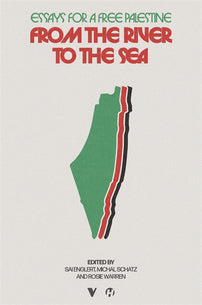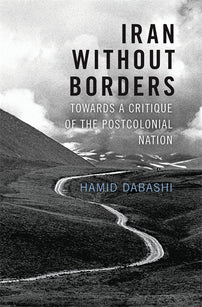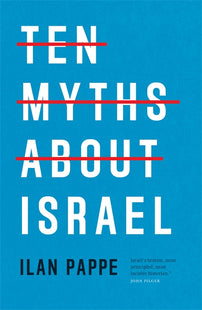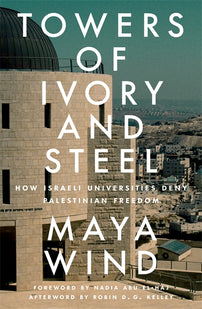Abandoned Legacy: The Left of Iran and Palestinians
Omid Montazeri charts the entwined histories of resistance and collaboration between the Iranian marxist and muslim groups and Palestinian liberation since the Nakba, and asks why this shared legacy has been abandoned today.

The genocide in Gaza has created new fault lines within the global Left. Friendships, families, relationships and solidarities have been cut through. For the Iranian Left, these fault lines have followed a binary logic. Some understand the different factions of resistance in Palestine as emancipatory movements for self-determination and others flatten them with their own experience of the Islamic Republic of Iran: backward and reactionary. This was not always the case. Palestine was once the beating heart of a united front, a “national liberation movement”, shared by many factions of the left in Iran. Returning to their shared history may open the path for reclaiming the abandoned legacy of the left.
*
In 1969, a faction of fighters from Al-Fatah, the main organisation within the Palestinian national Liberation Movement (PLO), attacked and successfully seized control of the Abinia kibbutz located along the border of Jordan with Israel. One of the commanders of this operation was a member of an Iranian communist nucleus later known as the Iranian People’s Fadai Guerrillas (OIPFG). His Palestinian Fadaiyan identity card bore the name Abu al-Abbas; while his Iranian birth certificate identified him as AliAkbar Safaie-Farahani. What prompted an Iranian Fadai to fight alongside Palestinians at this time?
About a year prior to the operation, Safaie-Farahani, along with his comrade Ali Safari-Ashtiani, were the surviving members of a small communist nucleus suppressed by Shah. While still in Iran, in 1967, the group had published a pamphlet titled Concerns of the Anti-Colonial Movement and the Duties of Communists where they decried the 1953 coup and its aftermath as the era of the "failure of the anti-colonial movement in Iran." In their view, the Shah's foreign policy showed an "Imperialist strategy against progressive liberation movements.” According to their analysis, ideological unity among Iran's communist, socialist, nationalist, and religious groups against the Shah had never materialised and the only possibility for "unity in action" hinged on armed struggle and engagement with Palestine.
With the pamphlet's publication, the Iranian Intelligence and Security Organization (SAVAK) identified and detained most members of the group. Safaie-Farahani and Safari-Ashtiani fled the country, but rather than heading to Moscow, they travelled via Iraq, Syria, Lebanon and ultimately to Palestine. For them, the Palestinian cause served as a crucial link between Marxism and anti-colonialism, and an essential tool for reassembling their intersection. The first three years of the journey transformed Safaie-Farahani into a seasoned guerrilla fighter, participating in various armed operations in the region. He also wrote What a Guerrilla Fighter Should Know.
[book-strip index="1"]
In February 1971, returning to Iran from Palestine, Safaie-Farahani led an armed group from the Iranian People's Fadai Guerrillas to attack the Siahkal police station. Safari-Ashtiani, who had been responsible for an Al-Fatah military warehouse, took charge of the armaments for this operation - a role that he later came to play for all guerrilla activities of the group.
Another group of guerrilla fighters emerged shortly after the Siahkal operation—the Mojahedin-e Khalq (MEK)—identifying as a left Islamic group. They too had connected with Palestinian fighters a few years earlier to prepare and train for armed resistance. Together these events marked the beginning of an era where the Iranian left identified itself as an armed struggle and national liberation movement.
Within months of the Siahkal operation, Safaei-Farahani was captured by security forces, subjected to torture, and killed. Al-Fatah's weekly magazine published a eulogy for him in an essay titled From Jordan’s Aghwar to Iran and Vice-Versa. Safaei-Farahani's death was commemorated as the "martyrdom" of Abu al-Abbas, a commander of the Palestinian Fadaiyan and the Iranian People's Fadai Guerrillas.

[The report of the killing of Abu Abbas Aliakbar Safaei-Farahani after the Siahkal operation. November 1971, Al Fatah Magazine.]
*
For the Iranian Marxist movements that emerged in the 1960s and 1970s, Palestine played a pivotal role in shaping their identity. Following the Six-Day War, Al-Fatah, under PLO, garnered substantial trust and reputation in the region. To the extent that their "Fadai" membership cards facilitated seamless movement across the national borders. Iranian resistance groups were closely affiliated with the PLO, assigning Arabic aliases to their members, providing Fadai membership cards and subsequently, Palestinian identity documents.
The initial wave of Iranian Fadai and Mojahedin reached the Palestinian camps in Jordan before the civil war in 1970. The Jordanian civil war, also known as Black September, saw violent clashes between the PLO and the Jordanian army. As a result, Palestinians were compelled to retreat to Syria and then to Lebanon, with their Iranian counterparts following suit.
The support extended by the PLO to Iranian armed groups was multifaceted. In strategic terms for example, they allocated an office space to the Mojahedin on the second floor of a prominent four-story building at the entrance to the Palestinian refugee camps of Sabra and Shatila. Supervision and training were provided by Khalil al-Wazir (Abu Jihad) and Salah Khalaf Abu Iyad, who were overseeing military and security affairs in Al-Fatah at that time.
[book-strip index="2"]
Their support had a theoretical dimension too. George Habash, a prominent leader of the Palestinian left, and the founder of PFLP, penned an introduction for the work of a martyred Fadai leader, Amir-Parviz Pouyan in 1974. Pouyan’s article originally published in the spring of 1970 was titled The Necessity of Armed Struggle and the Refutation of Survival. Habash recognised the importance of the essay for its conceptualization of armed struggle in national liberation movements. He emphasised the crucial role played by the guerrilla fighters in fostering solidarity between the Iranian people and the Arab people in general, and the Palestinian people in particular.
Through their association with Palestinians, the Iranian left established connections with other liberation movements in the region, particularly in Lebanon, Iraq, Libya, Yemen, and Oman. Low frequency radio channels transmitted updates on the revolutionary movements. Some Iranian fighters were stationed in the camps to coordinate with regional revolutionaries, while others, in groups of 10 to 15, were dispatched to the military training centres of Palestinian forces.

[Through their association with Palestinians, the Iranian left established connections with other liberation movements in the region, particularly in Lebanon, Iraq, Libya, Yemen, and Oman. credit: writer.]
Palestinian camps provided the Iranian left with crucial insights into the region and a fresh understanding of its geopolitics. This enabled them to become contemporary with their time and align with other national liberation movements in the global south. This network of alignments facilitated the opening of new frontlines against the Shah, particularly during the Dhofar War in Oman, where Iran’s state army supported Sultan Qaboos and the Iranian leftist fighter engaged in battle alongside Omani liberation forces.
It may be true that the Iranian left sought to connect with Palestine to learn the tactics of urban warfare. But history shows that they ended up living alongside Palestinians, forging emotional bonds, sharing meals, falling in love and ultimately fighting side by side. In the words of Torab Haghshenas, one of the first Mojahedin members stationed between Jordan and Lebanon: "We all developed an emotional bond with the people in the places we were stationed in. we became one with that place. We clapped at the celebrations and cried in the sorrows. We quickly learned the language there and mingled with the people."
[book-strip index="3"]
The left was not there at the start. Within two weeks after Nakba, on 15 May 1948, Iran’s recently formed Etehadie-Moslemin (Muslim Union), issued a call for volunteers to join the struggle in Palestine. Registration places were set up across the city of Tehran, attracting prominent Muslim intellectuals and clerics in support of the cause. Records indicate that around five thousand fighters registered to join their Palestinian brethren. Despite the significant interest, the Shah of Iran, refused to grant the necessary permits for the dispatch, leading to the cancellation of the initiative.
From their failure in the aftermath of Nakba until the early days of the 1979 revolution, the politically critical clerics, dissatisfied with the Shah’s stance, focused their efforts on cultural and literary activities.
An examination of the literature on Palestine published in Farsi during these three decades reveals the role played by these clerics in shaping the "Palestinian question" in the Iranian context.
Consider for instance, the 1964 Farsi edition of The Fate of Palestine and the History of Colonial Oppression by the Joradian diplomat Akram Zuaiter. The work stood out as one of the most influential literary pieces on Palestine and anti-colonial armed resistance in Iran. The edition was the work of translation by a young political cleric, Ali Akbar Hashemi-Rafsanjani, who had self-published the work without a permit or funding. Despite being banned by the Intelligence service SAVAK, the translation circulated widely. Mohammad Mossadegh, the former Prime Minister who was exiled after the 1953 Anglo-American coup, praised the translation and contributed funds for its wider distribution.
Up to this point, the prevailing writings within the established circles of the seminaries in Qom and Tehran were largely characterised by anti-Semitic sentiments. A notable example was a letter to the Pope in 1948 by a leading Shiite authority in Iran, Ayatollah Behbahani. In this letter, Behbahani voiced objections to the killing of Palestinian Muslims but the essence of his correspondence was what he described as a religious conflict between Jews, Muslims, and Christians, with a language that was distinctly anti-Jewish.
The young Hashemi distanced himself from the anti-Semitic narratives. Ayatollah Mahmoud Taleghani, co-founder of a Muslim and nationalist group named Nehzat-e Azadi (Freedom Movement of Iran) was another example of such political clerics. He visited Jerusalem in 1961 to witness the resistance of Palestinians and reported on his observations upon returning to Tehran at the Hedayat Mosque.
In subsequent years, the newly formed Mojahedin-e Khalq, supported the political clerics in Palestine related projects. For example, Torab Haghshenas acknowledged the pioneering role of Nehzat-e Azadi in addressing the Palestinian cause in Iran in his memoir. In 1968, his group translated a declaration on boycotting the state of Israel by the exiled Ayatollah Khomeini's and disseminated it across the country.
Apart from the clerics, other Muslim intellectuals were also contributing to the discourse on colonialism during this period. With the Six Day War in 1967 for example, Ali Shariati, drew parallels between the Zionism in Arab countries and the British Oil Company in Iran. Renowned Muslim writers such as Jalal Al-e Ahmad and Simin Daneshvar travelled to Palestine to learn from the struggle first hand. Gradually, the Palestinian resistance gained a broader resonance in Iran's civil and political movements.
[book-strip index="4"]
In the decade between the Six Day War in 1967 and the 1979 revolution, Marxists, anti-colonial nationalists and Muslim opposition groups collaborated to form a unified front in the name of Palestine and in opposition to Imperialism. This unified front haunted the Shah of Iran so much so that he described it as the resurgence of the "red and black"- a spectre that brought together the Marxist and religious anti-colonial movements in the region.
In the winter of 1979, following the revolution in Iran, the first international guests invited to Tehran to celebrate the victory were Palestinians. This included Yasser Arafat, chairman of PLO, and several leaders of the Al-Fatah movement. They arrived at Tehran airport on 17 February 1979, only six days after the revolution, and were greeted by members of the newly-formed Council of the Revolution who then accompanied them to the house of Ayatollah Khomeini.
Conspicuously absent from the pictures of their gatherings and celebrations, were figures from the Iranian leftist groups, namely the Organisation of Iranian People's Fadai and Mojahedin-e Khalq. Such absences signalled a rupture between a revolution and its revolutionaries.

[Yasser Arafat at his first official visit to Ayatollah Khomeini. February 1979. credit: iichs.ir]
Up until this moment, the Palestinian struggle had been a touchstone for many factions of Iranian Muslim, Marxist and anti-colonial resistance groups, inspiring and uniting the national liberation movement against the Pahlavi monarchy and imperialism. This united front shattered with the 1979 revolution. Nehzat-e Azadi came to power, their members joined the Council of the Revolution, established the temporary post-revolutionary government and laid the foundations of an Islamic Republic. Hashemi became a significant figure in Iranian politics, evolving into a game changer and kingmaker. They followed by a widespread suppression of the leftist groups that led to violent and bloody confrontations across the ensuing years.
From honour to melancholy, from victory to failure, from progress to retreat—remembering the path that connected the Leftist movements to Palestine is remembering an intense history, an image that is present but is not expressed, an abandoned legacy. Indeed, is this not the very definition of trauma?.
*
Four decades after the Revolution, only a handful of organised leftist and Marxist Iranian voices echo from within the region, with little more resonating across the Middle East. Throughout this time, the Iranian left grew distant from Palestine and movements such as Hamas for its fear of the position of Islam in the region’s national liberation movements.
Both the State of Iran and its leftist and Marxist opposition ignore the history they once shared with the Palestinian movement. In the aftermath of October 7th for example, both condemned Israel but from different rhetorical positions. The former supported Operation Al Aqsa Flood and the latter condemned Hamas. The former spoke in defence of Islamism, as the latter denounced the dangers of religious fundamentalism. For both fronts, the concern was not Hamas itself, but with the role of Islam within the conflict.
Following Russian Marxism, the Iranian Left recognised national liberation movements as forms of resistance against imperialism and the dependency of States to the west with useful contributions to progressive and bourgeois national-democratic revolutions towards socialism. Kamran Matin reintroduces the national liberation problem into the radical left debate in Iran.
Arab Marxism on the other hand, appreciated national liberation movements as foundations for the building of a united front amongst the Arab resistance groups in the region, including both Muslim and non-muslim factions. For the Lebanese theorist Mahdi Amel, Islam was determined in the field of “conflicting class-based political practices”. Amel’s book was published posthumously based on an unfinished manuscript that he had begun writing a year after the 1979 revolution in Iran. For him the question was not “whether islam is political (temporal) or not (and thus spiritual)”, but rather “how to define Islam’s political position”.
[book-strip index="5"]
Despite the political milieu of the 1970s, the Iranian Marxist groups did not engage with the discourse of Arab Marxism, perhaps because their writings were hardly translated into Persian. As such, their theoretical framework lacked the insights that were critical for organising in a society fragmented by class, religion and national minorities. Indeed, the dialogue was cut short.
Take for example George Habash’s note on the work of the Iranian Fadai leader, Amir-Parviz Pouyan. He had reaffirmed the “historical necessity” for the figure of the vanguard fighter, but insisted on the need to address, with the same attention, the issue of evolution from the vanguard to the revolutionary party. In his view breaking the frontiers of dictatorship did not pave the way for the masses to join revolutionary organisations. Since Pouyan was killed by the time of his writing, he concluded "this legacy rests upon the shoulders of future generations." Habash’s warning was not heard. The Marxist vanguards of Iran failed in organising the masses, and the revolution of 1979 came to miss-align with its revolutionaries.
The history of the national liberation movement in the region is written as a non-secular, non-democratic and homogenising kind. Behind the narrative and historiography of Iranian scholar Peyman Vahabzadeh on this topic for example, is a dark underground labyrinth where the monster of political Islam lay dormant. The different and differing leftist and Muslim groups who collaborated and formed the united front of a 'national liberation movement', did so while maintaining their singularities. Unseeing their multiplicity and flattening their singularities is to trap oneself within the epistemology of states and their international relations. Eskandar Sadeghi Broujerdi’s recent work on the position of the Islamic Republic and its approach to the Israeli state provides an example. As Naghmeh Sohrabi urges, it is time to disentangle the revolutionary process from the revolutionary outcome.
During the golden era of armed struggle in the 1970s, the national liberation movement provided a theoretical framework for cooperation between Muslim and leftist anti-colonial resistance groups in the Middle East. But today this framework has faded from contemporary debates among the left. During a recent exchange between Andreas Malm and Matan Kaminer, the discussion inevitably shifted to the question of united fronts and transnational movements. Malm pointed to the false dichotomy of Muslim and secular democratic resistance and called for re-centering the disputes and theoretical controversies within the left around a shared front. He rightly stressed that “the left in the global North has followed events since October 7 by paying little if any attention to the left that is there.” This is why we need to return to the experience of national liberation movements in the global south.
To bring sense and reason to this history, we must rewind to the very origin of Marxism in the region. Over a century ago, as early as the birth of socialism in Iran and the Constitutional Revolution in 1905, the problem of Islam was formulated in a letter to Lenin by the founder of the Iranian Soviet Socialist Republic, Mirza Kuchak Khan: In a Muslim society with many national and religious minorities, what response does the Left have to the problem of the front and its relationship with the masses?
For the Iranian Left, remembering Palestine, is remembering the relationship that once tied them to a united front at the scale of the region. It is remembering their abandoned legacy.
*** I'm thankful to Samaneh Moafi, assistant director of research at Forensic Architecture, for her collaboration in designing a precise methodology to recall a forgotten solidarity with Palestine.
Omid Montazeri is an essayist, journalist, and former political prisoner. He is a founding member of the Materialist Research Group, a farsi speaking leftist research group. Between 2020-23 he worked with the “Off-site project” as a researcher on State-building and violence in Post-revolutionary Iran. His main field of research is the intellectual and political legacy of communism and the radical left in Iran, since the 1960s and especially in the context of the 1979 revolution.




